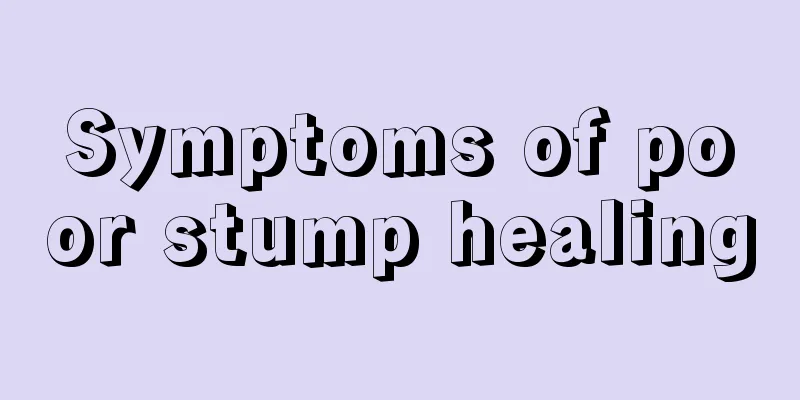Symptoms of poor stump healing

|
The uterus is an important organ in women and its main function is to conceive and nurture children. If a woman has some serious uterine diseases, such as uterine cancer, she will need to undergo a hysterectomy. After a hysterectomy, it takes some time for the stump to heal. There are also cases of poor stump healing. Below, we will introduce to you the symptoms of poor stump healing and other related knowledge! 1. Symptoms of poor stump healing Poor healing of the stump usually refers to the poor healing of the cervical stump after surgery, or the length of the vagina. If the healing is not good within one month after the operation, it will usually manifest as irregular vaginal bleeding, or infected and inflammatory secretions with an abnormal odor. If it is in the long term, contact bleeding may occur at the cervical stump or vaginal stump, and gynecological examination may reveal polyps formed at the stump. If the symptoms are poor healing and bleeding in the near term, antibiotics or topical medications that promote healing can be used appropriately. If it is a long-term condition, polyps need to be removed and laser electrocoagulation and hemostasis treatment are required. 2. Causes and treatments of poor stump healing Causes: Insufficient vaginal preparation before surgery, incomplete treatment of vaginal inflammation before surgery, lax vaginal disinfection, insufficient proficiency in intraoperative operation, increased intraoperative bleeding, incomplete hemostasis, prolonged surgical operation time, foreign body residue during surgery, if the patient is anemic and has a decreased body resistance, the blood supply to the stump healing is relatively insufficient, and the vaginal stump cannot be directly observed, causing inconvenience in postoperative observation. There are also surgical methods, the patient's own diseases such as diabetes, etc. Treatment: anti-infection, vaginal stump cleaning and medication, vaginal stump granuloma laser and other symptomatic supportive treatments. 3. How long does it take for the stump to heal? It usually takes 1 to 2 weeks for the vaginal stump to heal after a total hysterectomy. If the sutures are absorbable, they will be completely absorbed in about three months. At the same time, during the wound healing period, you should pay attention to rest, appropriate activities, keep the vulva clean, have smooth bowel movements, live a regular life, be in a good mood, eat nutritious vegetables and food, refrain from sexual intercourse, and prevent colds. If there is still a lot of bloody discharge or odor in the vagina two weeks after the operation, you should go to the hospital for a follow-up examination to prevent wound infection. |
<<: Leucorrhea turns yellow-green
>>: Normal values of luteinizing hormone
Recommend
How to play Go? Basic rules and strategies of Go
In ancient China, there were many names for it, s...
What else can the elderly do besides taking medicine when the flu strikes? | Popular Science Interpretation of Winter Respiratory Diseases
Editor's note: Recently, Guangming Online'...
Is drinking coffee harmful to the health of the elderly? What kind of coffee is good to buy?
Coffee is a slightly bitter drink, and there are ...
How should women with poor liver function treat their condition?
The liver is an important organ for detoxificatio...
Women have bad complexion and yellow face
Because women have a special menstrual period and...
Menstrual discharge is like pig liver
Women of childbearing age will have menstruation ...
The battle to protect the cervical spine begins during class breaks! The scientific magic of health exercises and the wave of health
In the modern learning environment, long periods ...
If you want to live a good life, don't eat too much! Eating too much often is more harmful than you think (not just getting fat)
People always eat too much easily, sometimes beca...
What are the yoga poses for postpartum recovery?
In today's fast-paced city, many people are u...
Women's process is too short and will accelerate aging
Generally speaking, the normal menstrual period o...
How is the regional economy of Tibet? What is the primary industry in Tibet?
The southern Tibet tourist area is centered in Li...
Don’t understand the endoscopic biopsy pathology report? Don’t worry, read here!
Author: Li Mingxian, Liu Taohua, Yang Haifeng, Gu...
What are the symptoms of uterine cysts?
Everyone should know a thing or two about the pro...
What is the periodic table called? The origin of the periodic table
The position of elements in the periodic table no...
How do women maintain their uterus and ovaries?
The uterus is a physiological characteristic of w...









